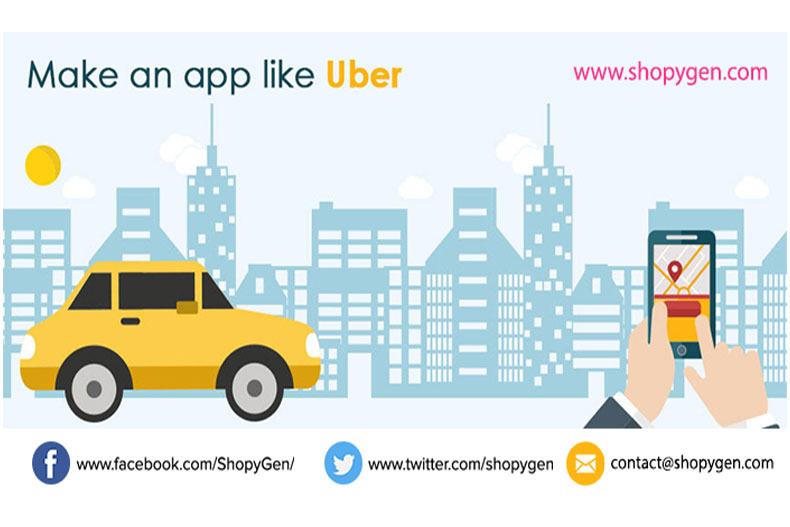It’s no surprise that Uber’s success fascinates you and encourages you to start a similar ride-sharing business. After all, Uber is one of the biggest success stories of the millennium. It made its founders, Travis Kalanick and Garrett Camp, billionaires, and Softbank can’t stop boasting of how they invested into it.
With a presence in over 70 countries and 600 cities, Uber is undoubtedly the most disruptive business in the world in the on-demand service marketplace. Trust me if you can attain even a fraction of Uber’s milestones in a niche, you too can disrupt the market significantly.
However, it’s not an easy job. Perhaps, more challenging than what it was to Uber itself. You must know everything from inside out if you want to create a similar platform even remotely to the Uber. I have briefed my entire research in eight points for ease of understanding. So be with me. Here are the things you should know:

Taxi is not the only option on Uber’s business model
Taxi or cabs are not the only traditional business models that you can bring in the online world with Uber’s model. You can follow a similar workflow and business model to port an entirely different industry on your version of the Uber-like platform.
What’s the core of Uber’s application? Its app-only ecosystem and real-time interactions with the on-demand service providers (cab drivers in Uber’s case). On a similar note, you can follow the same real-time interaction and on-demand service-booking feature to develop your own Uber clone for restaurant table booking, grocery delivery, courier, bike-rides, or to book on-demand plumbing, electrician, and handyman services.
The basic workflow changes as per the chosen niche
To do everything explained in the previous point, you must understand that the workflow of the Uber-like apps will also vary. The final cost and workflow your modified workflow will depend significantly on the kind of customizations you want in your app and how much you can invest in technologies as advance as Uber.
Uber’s basic workflow includes the following details:
- Key service: on-demand cab booking under various models: private; shared; rentals
- Key actors: Admin, Passenger, and Drivers
- Key flow: Trip request by Passenger => Ride matching process => Ride confirmation by driver => Ride => Payment => Rating by both driver and passenger
To port this workflow to a different service you have to understand the objective of your services and how the corresponding actors and elements of your app interact, and in what order. Your key strategy on how to build an app like Uber must include detailed research, planning, and documentation of the objectives, which you will present to your app developer to explain your exact requirements.
Technologies behind Uber’s solutions stack
Once you know your requirements, it’s time to know how Uber manages to keep its operations so smooth. Uber serves millions of passengers daily, and it’s not easy to maintain an exceptional uptime in such cases. Uber’s core application structure depends on numerous in-app, customized, and third party solutions, which work collectively on all the applications (passenger app, driver app, admin panel).
Uber’s tech stack has been evolving with its growth. They have been migrating from different tech stacks to meet the demands and implement the bests of the features. You can check on Stackshare to know their latest stack, or read Uber Engineering’s posts part 1 and part 2 to learn in deep.
However, while selecting your tech stack, you may compromise in many of the original technologies for cheaper alternatives. Uber has made its platform for billions of users. If you don’t think you are going to target billions, there is no point in investing in expensive technologies. The economical alternatives will work equally smoothly for limited target-base. For example, instead of developing two separate apps for passengers and drivers, you can develop a hybrid. Moreover, you can skip the website and go app-only.
How does Uber calculate the fare?
Fare calculation is the core source for Uber to make money. However, it is the trickiest part of the app development. Uber charges different fares in different regions, so it cannot use the same fare calculation logic for its entire operation.
However, the fundamental of fare calculation is similar throughout. The platform uses time, distance, ride-type, base fare, plus extra charges (toll, cancelation fee, waiting fee, tax, transaction fee, service charges, and surcharges) to come up with the final fare.
Hence, before knowing how to build an app like Uber, you must know how Uber calculates its fare and if all of its considerations are applicable in your business too. Depending on your adaptations to the factors, you can come up with your version of fare calculation logic.
Please note: while developing your Uber-like app, avoid hard coding the fare-logic. Instead, make it dynamic by devising a fare management module where you can change the base fare, add/remove fare factors, and other kinds of charges right from the back-end without messing with the code-base.
Features for the Passengers
Passengers make the key revenue source of your business. Besides Uber’s original features, you can select from N number of customizations to enhance the user experience. Here is a list of basic features that are must if you are developing even a remotely similar app to Uber:
- User registration
- Real-time ride booking
- Ride scheduling
- Ride cancelation
- Geo-tracking & navigation
- Multiple payment options
- Panic alerts system
- Review and ratings
- Ride history
- In-app chat support
Features of the Uber drivers
Drivers are likewise important for your business. You must ensure an equally user-friendly experience for your driver app as well. Here are some critical features for your drivers:
- Driver registration
- Accept/decline rides
- Geo-navigation
- Ride history
- Earnings analytics
- On-duty/off-duty modes
- Destination preference
- In-app messaging
- In-app driver support
- Rate passengers
Features for Admin
The usability of the admin panel depends on the features that fulfill your requirements and how easy it is to use. The Admin panel features are for you, and you should decide its look and features. The admin panel must have customized control systems as per the easiest ways to manage all the admin, passenger, and driver features from the back-end.
Be advised that the admin is the ultimate user. He/she should have access to everything. This brings us to the point that you also need sub-admin users with limited access. That’s why you should also ensure that your Admin profile lets you create sub-admin user accounts and offers access control. As per control systems are concerned, they may include features such as-
- User management
- Driver management
- Discount management
- Route management
- Bookings management
- Referral management
- Location tracking
- Vehicle management
- Ride management
- Support management
- Reviews management
- Payments management
- Payouts management
- Earnings management
- Fare management
- Site settings etc.
Cost of building an app like Uber
The entire platform of an Uber-like business works in coordination with multiple solutions. The final cost will depend on your requirements and the method of development.
Outsourcing: You can outsource your entire project to a good software development company. They usually charge on an hourly basis.
Uber clone script: Alternatively, you can purchase an Uber clone script and customize it to fit your personalized requirements. You can purchase an open-source code Uber clone with a one-time payment.
When you are outsourcing your entire project, it takes several months of development. Taking the per-hour development cost as low as $50, the overall development cost will go over $85,000 for the basic applications and a control panel. We are not including the cost of live testing and third party APIs in this.
When you opt for a ready-made Uber clone script, you get a group of pre-developed solutions, which include mobile apps for iOS and Android and the admin panel. Since these are readymade solutions, you will not have to pay any hourly development cost but a one-time fee. Moreover, the project won’t take much time. As per your requirements, a good Uber clone can come around for $1000-$3000. The best part is the open-source code access. Hence, you can use the same source code to build another on-demand service marketplace for some other niche, too.








